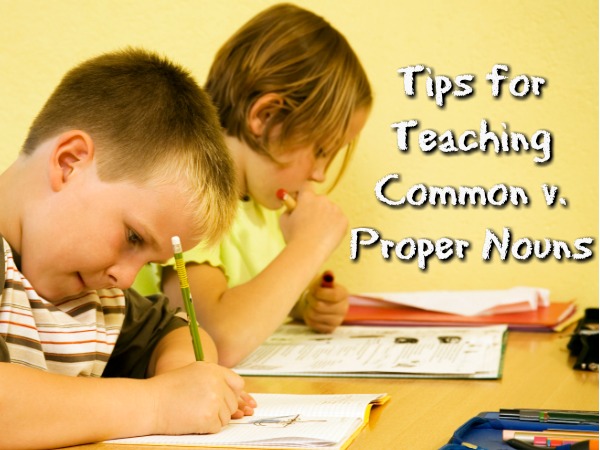Teaching common v. Proper nouns can be a challenge. Here are a few tips for Teaching Common v. Proper Nouns and a free worksheet to help your students understand this concept. Nouns are the basic unit of parts of speech. The simplified definition is a person, place, thing, or idea, but how do we help our kids understand the difference between common and proper nouns?

Common Nouns
Common nouns name a general person, place, thing, or an idea. There are three easy ways to figure out whether or not something is a common noun. First, if you can put an article in front of the word (a, an, or the) as in “the bird”, it can be a noun. If you can make a word plural as in “birds”, it can be a noun. Also, if you can add a possessive pronoun in front of a word (my, his, her) as in “her bird”, it can be a noun. If any of those conditions work, then your word is a noun.
Proper Nouns
Proper nouns are also people, places, things, or ideas, but they name a specific common noun. Proper nouns are always capitalized. For example, bird is a common noun but Tweety (a specific bird) is a proper noun. Car is a general word for a vehicle, but a Ford Mustang is a specific brand of a car.
Like any English rule, there are some tricks to proper nouns. A dog is a common noun, and a poodle is a specific dog, right? However, you would not capitalize poodle as it’s still a general thing (animal). If it has a modifier that focuses on a specific country, for example, French poodle, you would capitalize the adjective because it refers to a specific country.
Here are a few examples to help your child differentiate between common and proper nouns.
Common noun: park
Proper noun: Disney World
Example sentence: Last summer, my family took a vacation to Disney World, our favorite amusement park.
Disney World is a specific park.
Common noun: artist
Proper noun: Pablo Picasso
Example sentence: Pablo Picasso was an artist known for his unique style of painting.
Pablo Picasso is a specific artist.
A few common v. proper noun reminders:
- Months of year and days of the week are always capitalized (i.e. January, Wednesday).
- Seasons are not capitalized (i.e. summer).
- Adjectives that denote origin or place in front of common nouns are capitalized, but the noun is not (i.e. German shepherd, African violet).
- The first word in a sentence is always capitalized regardless of whether or not it’s a proper noun.Helping your child figure out the differences between common and proper nouns starts with being able to identify nouns. Understanding simple ways to test whether or not something is a noun will lead to better identification of the specific types of common nouns or proper nouns. Share these tips to help your child become a noun expert!
Grab your FREE Nouns Worksheet Below!!
Grab your Free Noun Worksheet By Signing Up
Subscribe to get our latest content by email.
